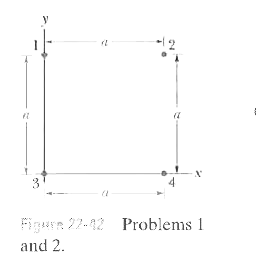Text Solution
Verified by Experts
Topper's Solved these Questions
ELECTRIC CHARGES AND FIELDS
RESNICK AND HALLIDAY|Exercise Practice Questions (Single Correct Choice Type)|45 VideosELECTRIC CHARGES AND FIELDS
RESNICK AND HALLIDAY|Exercise Practice Questions (More than one correct Type )|3 VideosELECTRIC CHARGES AND FIELDS
RESNICK AND HALLIDAY|Exercise Check points|9 VideosELASTICITY
RESNICK AND HALLIDAY|Exercise PRACTICE QUESTIONS (Integer Type)|3 VideosELECTRIC POTENTIAL
RESNICK AND HALLIDAY|Exercise (PRACTICE QUESTIONS) Integer Type|1 Videos
Similar Questions
Explore conceptually related problems
RESNICK AND HALLIDAY-ELECTRIC CHARGES AND FIELDS-Problems
- In Fig. four particles form a square. The charges are q(1) = q(4) = Q ...
Text Solution
|
- In Fig. , the particles have charges q(1) = -q(2) = 300 nC and q(3) = ...
Text Solution
|
- In Fig., particle 1 of charge +6.0 mu C and particle 2 of charge -2.0 ...
Text Solution
|
- Three particles are fixed on an x axis. Particle 1 of charge q(1) is a...
Text Solution
|
- In Fig., particle 1 of charge +q and particle 2 of charge +9.00 q are ...
Text Solution
|
- In Fig., particles 1 and 2 are fixed in place on an axis, at a separat...
Text Solution
|
- As a cat rubs its back along a carpet, it acquires a charge of +8.2 xx...
Text Solution
|
- Figure shows electrons 1 and 2 on an x axis and charged ions 3 and 4 o...
Text Solution
|
- The magnitude of the electrostatic force between point charges q(1) = ...
Text Solution
|
- In the return stroke of a typical lightning bolt, a current of 2.8 xx ...
Text Solution
|
- In Fig., particles 1 and 2 have charge 20.0 mu C each and are held at ...
Text Solution
|
- Two tiny, spherical water drops, with identical charges of -1.00 xx 10...
Text Solution
|
- The magnitude of the electrostatic force between two identical ions th...
Text Solution
|
- Two identical conducting spheres, fixed in place, attract each other w...
Text Solution
|
- Two equally charged particles, held 3.2xx10^(-3) m apart, are releas...
Text Solution
|
- The charges and coordinates of two charged particles held fixed in an ...
Text Solution
|
- In Fig., particles 2 and 4, of charge -e are fixed in place on a y axi...
Text Solution
|
- In crystals of the salt cesium, cesium ions Cs^(+) form the eight corn...
Text Solution
|
- Two particles are fixed on an x axis. Particle 1 of charge 50 mu C is ...
Text Solution
|
- In Fig., particles 1 and 2 of charge q(1) = q(2) = +4e are on a y axis...
Text Solution
|
